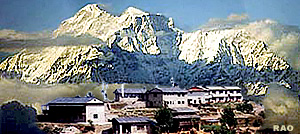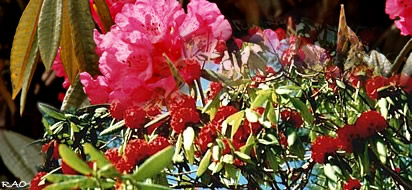 |
Charikot
- Dolakha: Region |
|
|
 |
 |
 |
| Rhododendron |
|
With flowers that grow in large clusters, the rhododendron species are found in Southeast Asia, from the Himalayas through Tibet, China, Nepal, Bhutan, Vietnam and to Malaysia and Indonesia. The wild rhododendrons are found from sea level to 6,000 m in elevation, and grow in many different habitats, including alpine regions, coniferous, and broadleaved.
Over 900 different species of rhododendron are existing worldwide.
 |
 |
A
wide range of tree species may befound in the area, ranging from subtropical
species at lower elevations to temperate kinds at higher elevations. Since
thre are too many species for all to be covered here, our intention is
to give you some help to enable you to idenfffy the more commonly encountered
species.
At
the lowest elevations the principal species is sal, or Shorea robusta.
lt is found along the Tama Koshi and its tributaries, but also upslope from
the rivers, up to about 1 500m. It occurs frequently pure stands and may
be recognised by its large, dark green leaves. It is the leaves of sal
which are used for food plates in various pujas or festivals. The bark
of the tree is dark almost black and characteristically has longitudinal
cracks. From March, sal leaves tum yellow, and by May the trees are almost
leafless. Sal wood is very durable, and economically it is one of the most
important species.
Found
sometimes in accossiation with sal is chir pine Pinus roburghii.
Altitudinally it ranges from the lowest eleveation in the district from
650 m up to 2000 m. It is sometimes a large tree, 35m or more in height,
and often is foundin pure stands. Chir pine yields good timber, and the
resin of the tree is sometimes collected for the industrial extraction
of turpentine. It is also used for domestic lighting.Up to about 1 800m,
chir pine is the only indigenous conifer likely to be encountered. The
large woody cone, up to 25cms in length, is a distinguishing characteristic
of this species. |
 |
Another
species occuring in a similar altitudinal range is chilane, or Schima
wallichii. It is a very common tree. Clues to its identity are its
five petalled white flower, and its sphericle fruit, about 2cms in diameter.
After seed shedding, the open frnits can be observed under the tree, the
sogments having opened and remaining attached to each other only at the
base of the fruit. Sometimes the foliage is used for fodder; the wood is
used for fuel and construction.
Worthy
of a special mention is the simal tree (Bombax malabarica) because
of its large red flowers, 20cms in diameter. Flowering takes place between
January and April, usually when the tree is leafless. Simal is often a
massive tree, 30m high with a thick bole, which at the base of the tree
may be a metre or more in diemeter. Simal is seldom seen above 1800m. |
 |
The
most spectacolar tree of November is the native cherryor painyo (Prunus
cerasoldes). It bears masses of pink flowers while leafless, and when
in flower is unmistakable. By April the flowers develop into red, cherry-like
fruit. Though it looks appetising, the fruit is not eaten.
From
2000m and upwards, evergreen oak (Quereus semicarpifolia), found
up to 2500m, is one of the principal species. Its foliage is often lopped
for fodder, and unless very remote from human habitation, it is seldom
found without its branches bsing heavily lopped. Mostly it is only the
"skeleton" of this species that is observed. The "skeleton" appearance
of the tree and its thick leaves with prickles along the margin are clues
to its identity. |
 |
|






